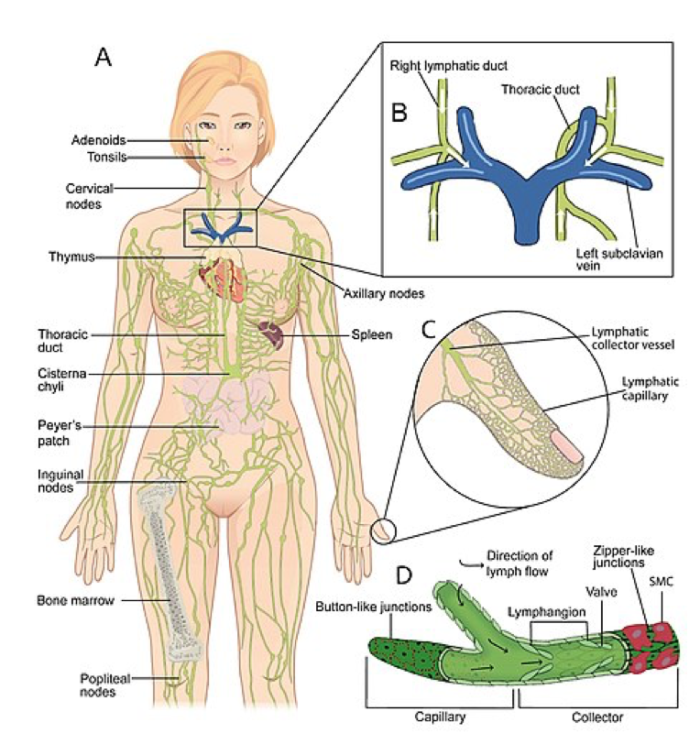
Yvette Jordan – UK Lymphology Clinics. The last two years have certainly taught us how quickly infection spreads and how to be aware of personal hygiene to reduce infection.
info@uklymphologyclinics.com
Nevertheless, now more than ever there is more reason to raise awareness that during winter and this time of year we should all be keeping our bodies extra healthy. The relatively unknown lymphatic system plays a crucial role in our ability to fight infection and disease and would therefore benefit from some extra help and continued attention to ward off infection effectively, particularly poignant today.

How the lymphatic system fights infection
The lymph system is directly involved in producing white blood cells called lymphocytes that seek out, capture, and destroy foreign substances – such as bacteria and viruses and other “invaders” and ultimately remove them from the body.
A slight tingling sensation underneath the tongue can be one of the first signs or symptom of an imminent cold, we also know that losing your taste, and smell is a sign of a Covid viral infection. This is your lymphatic system detecting invasion and starting the fight against infection producing extra cellular fluid to flood tissues in the submandibular lymphoid tissue. A sore throat accompanied with a runny nose, coughing and sneezing is the way of the lymphatic system excreting waste via open orifices especially lungs which also cause diaphragmatic pumping of the lymph.
With the mouth and lungs being the first contact entry point for infection rightly placed here are an abundance of lymphatics and lymphoid tissue. The mucosa-associated lymphoid tissue (MALT), is a diffuse system of small concentrations of lymphoid tissue found in various sites of the body and these include the oral passage, nasopharyngeal tract, lung and salivary glands. MALT is populated by lymphocytes such as T cells and B cells, as well as plasma cells and macrophages.
Tonsils are large clusters of lymphatic cells found in the pharynx. They are the body’s first line of defence as part of the immune system. Although tonsillectomies occur much less frequently today than they did in the 1960s, it is still among the most common operations performed and typically follows frequent throat infections but also leaves you more vulnerable with less ability to fight infection.

If the lymphatic system detects potentially dangerous bacteria, viruses, or other micro-organisms, deemed toxins in the blood, the spleen, home to an abundance of lymph nodes ready for infection, create in large quantities, white immune blood cells called lymphocytes and pass directly back into the blood stream. This process particularly active during infection creates inflammation and swelling of surrounding tissues. The splenic vein joins the hepatic portal vein and broken-down products of phagocytic activity from the splenic cells are carried straight to the liver.
Bone marrow is a key component of the lymphatic system, producing the lymphocytes that support the body’s immune system. Formation produces approximately 500 billion blood cells per day.

With up to 1,000 lymph nodes around the body, those fighting infection cause pain because they are swollen, the outer elastic and collagen fibre capsule becomes over stretched with extra lymph fluid. Infection may pass through hundreds of lymph nodes to finally destroy infection.
If the tonsil area is swollen around the throat and chin, regularly pressing in and around all these areas will help to keep your lymphatic system flowing naturally and reduce pain, as discovered by French doctors in the 1930`s.
Post infection
For some, lingering congestion and long-lasting effects can persist. Thankfully lymphatic drainage is a great post-infection massage and the ultimate hands-on recovery therapy which increases the movement of stagnant lymphatic fluid.
Having a lymphatic drainage massage post-infection, you can help to improve the flow of the lymphocytes, macrophages, and waste fluid. Ultimately if you stimulate the body`s ability to fight infection even residual and niggling effects can be eliminated long after we have recovered.
Post-infection the body needs much more lymphatic movement and if these symptoms persist it means it is struggling and continues to let you know through these symptoms. The one thing you should not do is to let these continue, use lymphatic drainage to move and increase lymphatic flow.
Summary
Originated by Emil Vodder PhD and his wife, Estrid Vodder, ND in the 1930s, lymphatic massage owed its original success by visibly reducing sore swollen throats healing patients much faster. It was used for five years and became an effective method of natural healing to alleviate painful symptoms but sadly we don`t use it to benefit us like that today!
Stagnating toxins or trapped residual waste from cellular and metabolic activity are a major contributing factor in the development of disease. Lengthy recovery with swelling or oedema allows waste to build up and remain in the body, eventually causing harm to some degree – from general aches and pains, swollen abdomen with digestive issues to degenerative and autoimmune diseases, all the way to cancer.
Therefore, during winter and all year round, especially nowadays, I would highly recommend monthly lymphatic massage and self-lymphatic drainage to help speed up the removal of any extra residual fluid within the body. Our waste system can always do with a helping massage hand to improve its slow-moving infection fighting ability giving much faster recovery and ultimately a healthier body inside.